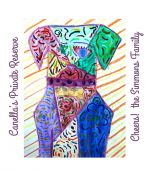Northwest Cellars Blog
Award-winning wines and custom wine labels. Wine. Now it gets personal.
A Peek at Pinot Gris


Pinot gris grapes hanging on vines
Let’s talk about a grape that I don’t think gets much consideration. I’ve always thought of it as a simple, inexpensive and unextraordinary wine as I think many people do. You know, the perfectly quaffable cold drink you put in the plastic glass on a hot afternoon out on the patio or balance on your belly while floating in the pool. I have to admit I have done it. (Don’t tell Bob!) But when I started looking into it, I found this grape to have a much more interesting, and, dare I say, more complex, story. I have come to experience more of the real thing and I hope you will too.
A PEEK AT PINOT PRONUNCIATION
Shall we start with pronunciation? Gris is the French version pronounced gree. It rhymes with me. Or the exclamation “gee.” As in “Gee, Lassie, how did I get to the bottom of this well?”
Grigio is the Italian version pronounced greejo. Most people say gree-gee-o. But Italians barely say the “i.” As in”Hullo, you educated wine drinker.”
Gris/Grigio simply translates to the word grey. Pinot Gris is originally from France and is in the Pinot vine family. These grapevines are very susceptible to spontaneous mutation and Pinot G is an ancient, natural color mutation of Pinot Noir. Noir means black and these grapes are a lighter version of them. And, by all accounts, they can vary greatly fromy ellowish grey to brownish pink to blue grey, purplish or even white.
This can even happen in the same cluster. But for some reason they settled on calling them generically “grey.” And this mutation has been growing wild in the fields around Burgundy since the Middle Ages. And, of course, since nothing seems to stay put, it went off a-traveling. First to Switzerland then to Hungary and then to Germany where, in 1711, a German merchant named Seger Ruland re-discovered it, began making wine from the grapes and very humbly decided to call this wine Rulander. Since then it has been discovered to be Pinot Gris. But to this day Rulander is one of the German names for this wine along with the other name it is known by, Grauburgunder. For some reason, I love saying Grauburgunder out loud. Try it. It will make you want to wear lederhosen.
A JOURNEY THROUGH TIME AND LANDS
Historically, in the 18th and 19th centuries, Pinot Gris was quite popular in the Burgundy and Champagne regions of France. Unfortunately, it was an unreliable crop and poor yields caused it to fall out of favor. But since then vine breeders in the 20th century were able to develop clonal varieties that were more dependable and saved its little grape life. Now it is so popular it is grown in virtually every wine region of the world.
Pinot Gris is an early budding and early ripening grape. It is naturally low in acidity and matures early with the grapes producing high sugar levels. So it is best grown in cool climates at higher elevations where it can maintain higher levels of acidity in order to produce wines with the desired degree of freshness. In fact, because of its early maturation, Pinot G’s are considered an “early to market wine” that can be bottled and out on the market within 4 to 12 weeks after fermentation.
BACK DUE TO POPULAR DEMAND
This wine has enjoyed increasing popularity over the last 20 years, especially in its Pinot Grigio incarnation. Even though it is French in origin, it has really been the Italians that have brought it such huge global recognition and fame. In fact, it is Santa Margherita Winery in particular who first made Pinot Grigio as we know it today, beginning in 1961, in its white wine style with freshness and good acidity. By the way, this winery today is carbon neutral with sustainable agricultural practices. A good thing.
TASTES LIKE…
Pinot Gris is a versatile grape. The wines can range from bone dry to sweet. First let’s talk more about the Italian style. We know it grows best in cooler areas so the best Pinot Grigios come from the steep Alpine valleys in northern Italy, areas like Alto Adige and Friuli. The wines from here are generally characterized as dry and minerally. These are the leanest styles that are lighter bodied with high acidity and more pronounced fruity-spicy-earthy flavors like peach, green apple and almond. They are fresh with some citrus flavors, stonefruit, and floral aromas. They do not go through malolactic fermentation so retain a light, crisp body and texture that is refreshing on the palate and can be characterized as thequintessential Pinot Grigio. This style also is predominant through Austria, Slovenia and Hungary. The less expensive, simpler style comes from warmer, flatter regions like Veneto and are generally mass produced. If you have been purchasing these just remember, you can do better!
Now, back to France, the country of origin. In particular, Alsace. It is this region in France where the Pinot Gris grape is most cultivated and most sophisticated. The highest quality wine comes from here. And even though it is the same grape as Pinot Grigio it has a markedly different character than the Italian style for several reasons. Alsatian Pinot Gris wines are full bodied and tend to have lower acidity, higher alcohol levels, and a certain“oily” or “unctuous” texture that contributes to the full bodied nature of this style. They are fruity and dry with a notable spicy quality. Flavors of ripe tropical fruit, notes of melon and mango, bitter almond, cinnamon and ginger, yellow apple and a little smoke and earth are common descriptors of this wine. Malolactic fermentation is generally employed which changes the brighter, sharper acids in the wine to more mellow, buttery acids contributing to the creamier mouth feel.
Furthermore, unlike Pinot Grigios, they can be oaked and cellared to age.
FOR THE SWEET TOOTH…
Another notable iteration of this grape are the famous sweet wines from Alsace. Alsatian grapes can be prone to Noble Rot so are sometimes made into SGN’s or Sélection de Grains Nobles (which is a mouthful thus the abbreviation.) These are rich, concentrated dessert wines that are in a category all to themselves. Another dessert wine produced from Alsatian Pinot Gris is called Vendage Tardive made from grapes that are left to hang on the vine to shrivel and gain concentrated sweetness. But, as I say, these are wines in a class of their own. If you like dessert wines, they are definitely worth checking out.
Also interesting is a copper colored rosé from Italy made from Pinot Gris grapes called Ramato. This is more in the orange wine category which also would be worth checking out.
As I stated above, Pinot Gris is now grown the world over including the New World wine regions. These vines can be found in Australia, New Zealand, South Africa, Argentina, int he US and many other countries. Most of these wines are produced in the more popular,easy drinking and inexpensive style, made for early consumption. Closer to home we can find lovely expressions of the French Pinot Gris style coming from California, Washington state, and Oregon. In fact, speaking of Oregon, Pinot Gris is the second most important grape grown there (after Pinot Noir) coming from the Willamette valley.
PAIR WITH
As far as food pairings go, the different styles go with different foods, of course. And evenwithin the styles, whether they come from a warmer climate (peach, nectarine, apricot,yellow apple) or a cooler climate (citrusy lemon and lime, green apple, melon) can make a difference in food matches. Remember, the body of the wine should match the weight of the food. Or, if different, they should complement each other. In general try foods like oven-roasted chicken, grilled chicken or pork, cream sauces and mac ‘n cheese. Mushrooms and spicy food would be nice. Try sushi, veggies and light cheeses with the higher acid citrusy wines. Of course, just on its own, as an aperitif, is always a good option too.
FOR THE FINAL TEST!
And now for the delicious part! Here’s what I tasted:
Pinot Grigio, 2021 Friuli, Italy DOG Grave $13.99 Albino Armani
12.5% abv Straw colored with glints of gold.
Very aromatic with honeydew melon and white peach. Kind of flinty and saline with a hint ofbaby powder on the nose. It tasted nutty with notes of dried green apple, peach andmineral and a fairly long finish. Satisfying and tasty!
Pinot Grigio 2021 Hungary $10.99 Kiwi Cuvée Bin 36
12.5% abv Very pale straw color with a slight coppery cast. This was lighter in body than the Italian PG above.
It smelled clean, like rain, touches of talc/mineral. Walnut shell, a touch of apricot andgreen apple. The taste was also lean and clean with cherry pit, bitter almond, a slightsalinity and a bit spicy. It had a short finish and I did not find this wine as interesting.
Pinot Gris 2021 Willamette Valley, Oregon $15.99 Samuel Robert Winery
13% abv Light straw color.
Somewhat shy but presented some apple and pear on the nose along with lots of mineraland pine nuts. And just plain pine. It was surprisingly fruity on the attack with a creamiermouthfeel. Lots of spice, almost peppery with some softer yellow apple. Quite good. More of a food wine I think.
Pinot Gris 2017 Alsace, France $34.99 Anne de K Schlossberg Grand Cru
13% abv A gorgeous gold with copper highlights.
Surprise! This is definitely off dry which is not what I was expecting. But maybe I shouldhave after a more distinctive nose of almond, yellow peach, caramel and some floral rose.Full bodied with tropical fruit notes, honey, canned peaches and some lychee. Withmedium acidity it is juicy, very tasty and has a nice long finish.
The wrap up:
I found every single one of these wines to be, more or less, minerally and spicy with some lychee notes. Less mineral in the 2017 Schlossberg but still a touch. They are very approachable with pretty darn good price points. They are much better wines, and more to my liking than I had anticipated. One could drink these all summer, with various foods prepared in various ways with the various styles of this wine. Or alone.
Or on the deck. Or floating around on the big blowup ducky in the pool.
Enjoy y’all!
Cheers until next time,
Peggy
Recent Custom Wine Labels
Recent Blog Posts











